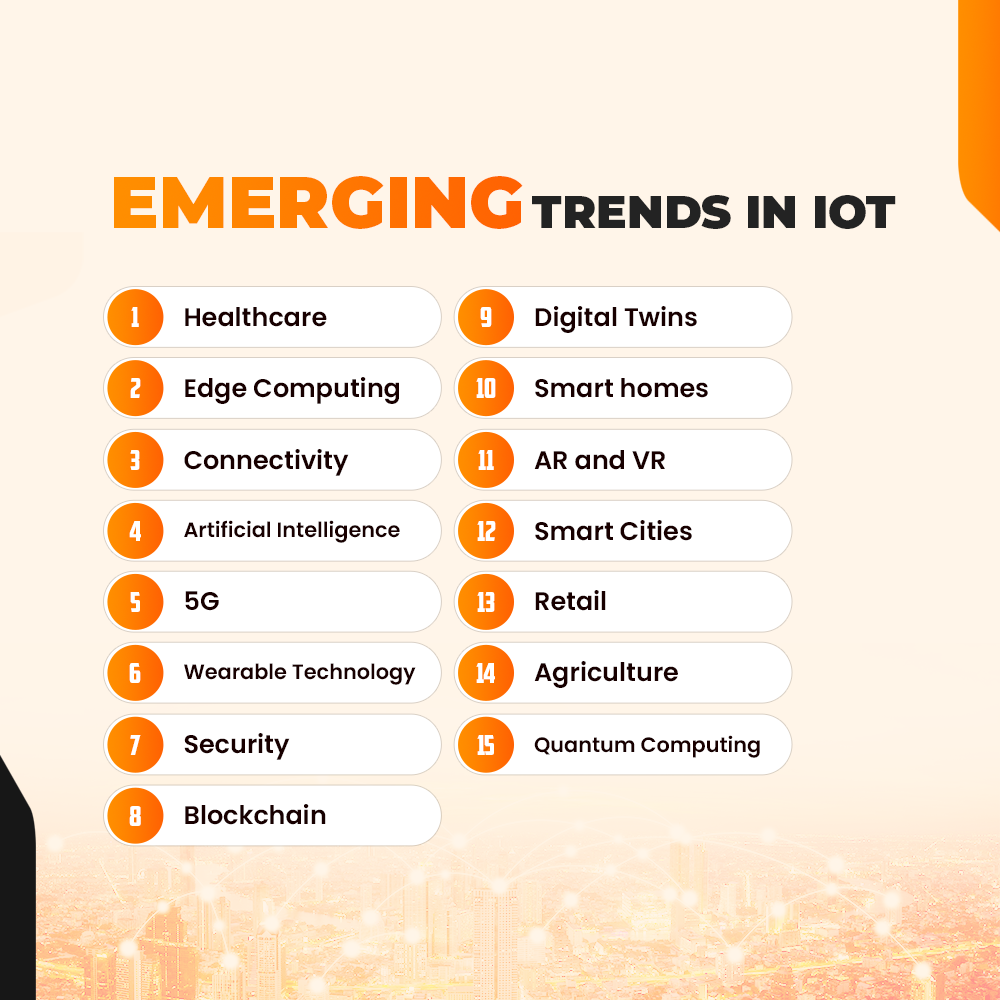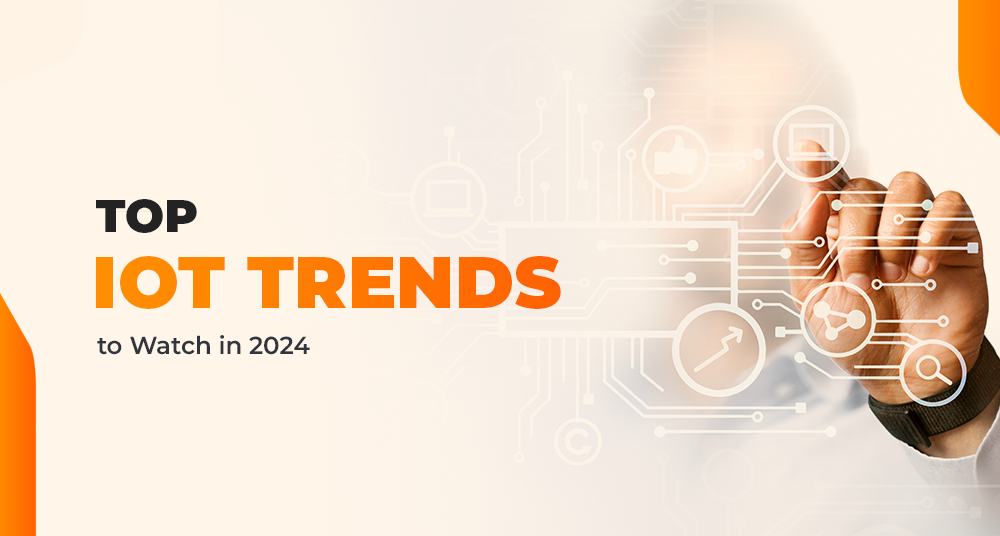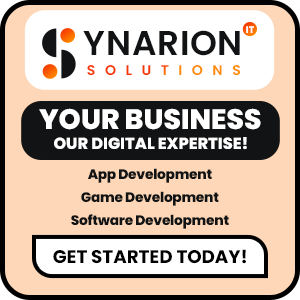Despite technological advances, the IoT changes how we interact with the world. The massive IoT links household and industrial devices. Automation, efficiency, and convenience come from networked devices.
In this digital age, IoT is crucial. Healthcare, agriculture, urban planning, and industry promote innovation. The Internet of Things simplifies Data sharing between devices, improving digital intelligence, productivity, and decision-making.
Technology and the need for connected solutions grow the Internet of Things ecosystem. This evolution increases device proliferation, security, and interoperability. As edge computing, AI, and 5G connectivity push boundaries, the IoT becomes more important for our digital future.
Internet of Things innovations in 2025 will be fascinating. This blog covers the top IoT trends that will impact the market. Internet of Things issues like edge computing, security, green energy, and medicine will be discussed.
Watch as we reveal IoT trends affecting society and the global economy.
Interesting Statistics Related to IoT in 2030
The following 2030 IoT data is fascinating:
- There are well over 18.8 billion connected IoT devices around the globe
- It’s expected there will be 25.44 billion IoT devices by 2030
- IoT devices surpassed non-IoT devices in 2020
- There are more than 400 active IoT platforms in existence
- Video entertainment is the biggest spending category in IoT
Top IoT trends in 2025

The top IoT trends for 2025 are as follows:
Growing Uptake of 5G Networks
The IoT will change due to 5G networks’ faster and more reliable device communication. Next-generation wireless technology promises faster data rates, lower latency, and more capacity. 5G will boost IoT in driverless cars, smart cities, healthcare, and industrial automation. 5G networks will enable IoT ecosystem innovation and efficiency by seamlessly exchanging massive amounts of data in real time.
Edge Computing Dominance
IoT devices generate massive amounts of data that must be processed immediately, demanding edge computing. Network data processing is decentralized with edge computing. Placing computational resources near the data source reduces the need to transfer data to a cloud or data center. Transmission costs and low latency enable real-time or near-real-time applications. Edge computing enables smart cities, split-second manufacturing, and healthcare decisions. Transporting sensitive data securely and privately is beneficial. Due to IoT devices and data processing speed, edge computing is needed for faster, smarter, autonomous systems.
AI and Machine Learning Integration
Smart technology will become intelligent and connected with AI and machine learning in IoT devices. This fusion allows IoT devices to learn, recognize patterns, and make decisions without human intervention. As they improve predictive analytics, these devices can optimize energy consumption, predict maintenance needs, and prevent failures, improving operational efficiency and reliability.
AI-enabled autonomous decision-making helps smart cities manage traffic and make smart homes easily adjust to comfort. AI-driven personalization makes technology more engaging and intuitive by tailoring user experiences to preferences and behaviors. IoT devices are becoming proactive, adaptive systems that respond to commands, anticipate needs, and improve user experience using AI and machine learning, changing how we live and work with technology.
Enhanced IoT Security
With more IoT devices, the networked ecosystem becomes more complex and large, making security a priority. This surge in connected devices increases the cyberattack surface, requiring more advanced security measures. Cybersecurity experts and technologists improve encryption, device authentication, and threat detection and response. These safeguard data, privacy, device communication, and infrastructure from hackers. The use of security-by-design in IoT application development is also rising. A proactive approach, continuous monitoring, and regular updates protect the IoT ecosystem from ever-changing cyber threats, ensuring trust and reliability for widespread adoption.
IoT in Healthcare Transformation
Telehealth IoT and remote patient monitoring will grow with healthcare digitization. Growing awareness of the need for more accessible, effective, and individualized healthcare drives this surge. Real-time patient health data from wearable health monitors and connected medical devices helps manage chronic diseases and diagnose them early. IoT-enabled telehealth platforms let patients see doctors from home, relieving hospital strain and making healthcare more accessible to remote and underserved populations. IoT data can improve treatment outcomes, understand patient health trends, and advance medical science. As healthcare evolves, IoT will make healthcare more connected, efficient, and patient-centric.
Related Guide:- https://blog.synarionit.com/healthcare-app-development-in-2025/
Smart Cities/IoT
Interconnected, intelligent IoT ecosystems will accelerate smart city development. Streetlights, traffic signals, water supply, and building IoT sensors and devices improve management and efficiency. A vast network of connected devices enhances public safety, energy efficiency, and traffic flow by monitoring and analyzing city operations in real-time. While intelligent traffic management systems lessen traffic by modifying signal timings, intelligent energy systems modify the heating and lighting of public buildings to conserve energy. Real-time data from IoT-enabled emergency response and surveillance systems can also safeguard citizens. IoT technologies will enhance urban living and strengthen cities’ sustainability and resilience as they expand and encounter logistical and environmental challenges.
Sustainable IoT Solutions
The Internet of Things is getting greener. IoT solutions strategically address energy management, resource conservation, and environmental footprint reduction. IoT devices can reduce waste by dynamically adjusting home and business electricity use with smart energy systems. Smart IoT sensors monitor crop health and soil moisture to maximize yield and save water and fertilizer. IoT waste management apps optimize collection routes and schedules and monitor waste levels to increase recycling and reduce landfill use. Real-time analytics and data from IoT technologies help individuals and businesses make sustainable decisions. Strategic IoT use can help advance global sustainability and resource conservation.
Precision Agriculture with IoT
IoT will enable precision farming, which optimizes crop yields and resource use, revolutionizing agriculture. Field sensors let farmers monitor pests, temperature, humidity, and crop health in real time. This knowledge helps apply pesticides, fertilizers, and water precisely and on time, reducing waste and environmental damage. IoT devices can boost productivity by automating planting, harvesting, and irrigation. To improve agricultural management, drone mapping uses advanced imaging to assess soil and crop health. Precision farming with IoT boosts crop yields and reduces losses to meet global food demand. Technology boosts agricultural productivity and sustainability.
Industrial IoT (IIoT) Growth
Industrial IoT will transform manufacturing and industry. IIoT boosts efficiency and productivity with advanced sensors, automation, and machine learning. Systems and equipment for monitoring enable quick adjustments, which cut down on waste and downtime. Predictive maintenance increases the lifespan of machinery and guarantees continuous operation by utilizing AI algorithms to evaluate sensor data and forecast equipment failures. Industry digital transformation boosts manufacturing innovation, product development, and efficiency.
Rise of Smart Home Appliances
Smart home appliances are growing due to consumer demand for convenience, security, and energy efficiency. These devices, from facial recognition security cameras to smart thermostats that adjust temperature and humidity based on user behavior, are becoming more important. Users can control home settings with voice assistants and smart speakers. This use increase reflects a trend toward automated, networked homes that offer customized experiences and promote sustainability.
IoT Streamlines Logistics and Supply Chains
IoT will improve logistics and supply chain efficiency. Shipping locations and conditions can be tracked in real-time using GPS and RFID technologies, minimizing loss and facilitating prompt decision-making. IIoT-enabled inventory management systems provide automated stock replenishment alerts. help of supply chain data, predictive analytics can precisely predict demand, maximizing inventory and cutting expenses. These developments will revolutionize logistics, increasing the efficiency and dependability of deliveries.
Voice and Conversational Interfaces
Users’ interactions become more intuitive and natural when voice assistants and conversational interfaces are integrated into Internet of Things devices. This pattern indicates a move toward technology that is more human-centric, where commands can be given using everyday language, lowering learning curves and improving user experiences. Voice and conversational AI are making digital interactions easier, especially for people with physical or visual impairments, whether they are controlling smart home devices, accessing information, or performing tasks.
Quantum Computing’s Impact on IoT
Quantum computing may have a major impact on IoT despite its early stages. Quantum computing’s processing power and ability to quickly compute complex computations could improve IoT data security and analytics. Quantum encryption could solve one of the biggest IoT deployment issues by providing unbreakable data transmission security. Quantum computing’s ability to process large datasets could unlock new insights from IoT data, spurring innovation in many fields.
Increased IoT Device Interoperability
Standardizing IoT technologies and protocols is essential for device interoperability. As the IoT ecosystem grows, seamless integration and management of diverse devices and systems are essential. Standardization efforts establish frameworks and protocols for device communication and collaboration across manufacturers. This simplifies IoT deployment and management and allows more complex and functional IoT applications, creating a more connected and efficient world.
Rise of Digital Twins
The rise of digital twins has improved IoT system management and optimization. Using real-time sensor data, digital twins are virtual versions of physical systems or devices. It allows deep, analytical, and simulation-based understanding and prediction of IoT devices and system behavior under various conditions.
Conclusion
5G technology is transforming the IoT, especially in healthcare. This technological revolution will transform healthcare delivery. 5G’s speed, reliability, and connectivity will improve IoT applications and expand possibilities.
5G will revolutionize healthcare with IoT, telehealth, remote patient monitoring, and surgeries. Proactive, individualized, and accessible healthcare improves patient outcomes and quality of life. In real-time, health data analysis and prediction could improve preventative care and reduce global healthcare system strain.
5G and IoT’s healthcare benefits must be balanced with infrastructure investment, data security and privacy, and regulatory compliance. To maximize 5G healthcare potential, these issues must be addressed.
5G networks will improve healthcare IoT efficiency, effectiveness, and equity. This technology must improve patient care while protecting health data’s security, privacy, and ethics in this new era. The potential of 5G and IoT in healthcare can be fully realized with careful planning and cross-sector collaboration, ushering in a new digital health and wellness era.






What do you think?
It is nice to know your opinion. Leave a comment.